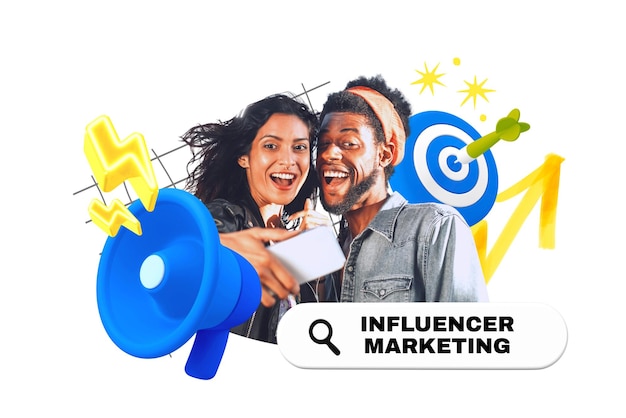Unlocking the Power of Social Media Influencer Marketing: A Modern Brand’s Guide
In the rapidly evolving digital landscape, brands are constantly searching for innovative and impactful ways to connect with their target audience. One of the most effective and dynamic methods to emerge in recent years is social media influencer marketing. This strategy leverages the reach and credibility of individuals who have cultivated dedicated followings on platforms like Instagram, YouTube, TikTok, and Twitter to promote products, services, or brand messages. As consumers grow more skeptical of traditional advertising, influencer marketing offers a more authentic and engaging approach to communication. In this comprehensive blog, we will explore what social media influencer marketing is, its benefits, different types of influencers, how to create an effective influencer marketing campaign, and the trends shaping its future.
Understanding Social Media Influencer Marketing
Social media influencer marketing is a form of collaboration between brands and influencers—individuals who possess a significant and loyal following on social platforms. These influencers have the ability to affect the purchasing decisions of others due to their authority, knowledge, position, or relationship with their audience. Influencer marketing is rooted in the trust followers place in influencers, which is why their endorsements often carry more weight than traditional advertisements. From fashion and beauty to fitness, tech, and lifestyle, influencers exist across all industries, allowing brands to target specific niches with precision.
Why Social Media Influencer Marketing Works
The effectiveness of social media influencer marketing can be attributed to several key factors. First, influencers create content that resonates with their audience. Whether it’s through engaging videos, stunning photos, or informative blog posts, their content is tailored to fit the preferences and interests of their followers. This personalized approach often leads to higher engagement rates than traditional ads. Second, influencer marketing provides social proof. When potential customers see someone they admire using a product or service, they’re more likely to believe in its value and consider purchasing it themselves. Third, it helps brands reach specific demographics more accurately. Influencers often cater to well-defined audiences, which makes it easier for brands to connect with their ideal customers without wasting resources on broad and less effective campaigns.
Types of Influencers in Social Media Marketing
Not all influencers are created equal, and they are often categorized based on their follower count. Mega-influencers typically have over a million followers and are often celebrities or public figures. They have a massive reach but may lack the niche engagement that smaller influencers offer. Macro-influencers have between 100,000 to 1 million followers and often focus on specific interests or industries. They offer a good balance of reach and engagement. Micro-influencers have between 10,000 to 100,000 followers and are known for their high engagement rates and strong connection with their audience. Nano-influencers, with fewer than 10,000 followers, often have the most intimate relationships with their followers and can drive impressive results through authenticity and trust. Depending on your campaign goals, budget, and target audience, different types of influencers may be more suitable for your strategy.
Building an Influencer Marketing Strategy
Creating a successful social media influencer marketing campaign requires strategic planning and execution. The first step is to define your goals. Are you looking to increase brand awareness, drive traffic to your website, generate sales, or build social media engagement? Clear goals will guide every other aspect of your campaign. Next, identify your target audience. Understanding who you want to reach will help you choose the right influencers. Once you’ve defined your audience, start searching for influencers who align with your brand values and have followers that match your target demographic. Tools like BuzzSumo, Upfluence, and AspireIQ can help you discover suitable influencers.
Evaluating and Collaborating with Influencers
When evaluating potential influencers, don’t just look at follower count. Engagement rates, content quality, authenticity, and audience demographics are equally important. Review their previous brand partnerships to assess how well they align with your brand image. After selecting your influencers, collaborate on content ideas. Give them creative freedom while providing clear guidelines to ensure brand consistency. Influencers know what resonates best with their followers, so allowing them to craft authentic messages can lead to better results. Establish clear contracts outlining the scope of work, deliverables, deadlines, and compensation. This will protect both parties and ensure a smooth collaboration.
Measuring the Success of Influencer Campaigns
To understand the effectiveness of your influencer marketing efforts, you need to track key performance indicators (KPIs). Common metrics include reach, impressions, engagement rate (likes, comments, shares), click-through rate (CTR), conversions, and return on investment (ROI). Use tracking tools like UTM parameters, promo codes, and affiliate links to measure traffic and sales generated by each influencer. Additionally, monitor sentiment analysis to understand how the audience is responding to your campaign. By analyzing the data, you can optimize future campaigns, choose better influencers, and improve your overall marketing strategy.
Benefits of Social Media Influencer Marketing
One of the biggest advantages of influencer marketing is its ability to humanize your brand. Influencers present your products in real-life scenarios, making them more relatable to potential customers. It also allows for precise targeting. With the right influencer, you can reach a very specific audience based on age, location, interests, and behaviors. Influencer marketing is also cost-effective compared to traditional media advertising. Particularly with micro and nano-influencers, you can achieve significant results without a massive budget. Moreover, it boosts your SEO and content strategy. Influencers often create high-quality, shareable content that can enhance your brand’s online presence. Lastly, it provides long-term value. Unlike a TV ad that runs for a few days, influencer posts often remain visible on social platforms for weeks, continuing to generate engagement.
Challenges in Influencer Marketing
Despite its benefits, social media influencer marketing is not without challenges. One major issue is influencer fraud, where individuals use fake followers or engagement to appear more influential than they are. This can lead to wasted budget and poor results. To avoid this, always vet influencers thoroughly. Another challenge is maintaining authenticity. Overly scripted or salesy content can turn off audiences. It’s essential to strike a balance between brand messaging and the influencer’s natural voice. Additionally, managing multiple influencer relationships and campaigns can be time-consuming. Using influencer management platforms can help streamline the process. Lastly, measuring ROI can be difficult, especially for brand awareness campaigns. Combining qualitative and quantitative metrics can provide a more holistic view of your campaign’s impact.
Trends Shaping the Future of Influencer Marketing
Influencer marketing is constantly evolving, and staying ahead of trends is crucial for continued success. One major trend is the rise of video content. Short-form videos on platforms like TikTok, Instagram Reels, and YouTube Shorts are dominating social media and offer high engagement opportunities. Brands are increasingly focusing on creators who excel in video storytelling. Another trend is the shift toward long-term partnerships instead of one-off campaigns. This helps build stronger brand-influencer relationships and more consistent messaging. Authenticity is becoming more important than ever. Audiences prefer influencers who are transparent and genuinely use the products they promote. The integration of AI and data analytics is also enhancing influencer marketing. Advanced tools can now predict campaign success, identify fake engagement, and match brands with the most suitable influencers. Additionally, there is a growing emphasis on inclusivity and diversity. Brands are working with a broader range of influencers to connect with various communities and promote social values.
Examples of Successful Influencer Marketing Campaigns
Several global brands have leveraged social media influencer marketing to great effect. For example, Daniel Wellington, a watch company, built its brand almost entirely through influencer partnerships. They collaborated with thousands of micro-influencers who showcased their products with a unique promo code. The campaign’s success led to massive brand visibility and sales. Another example is Gymshark, a fitness apparel brand that partnered with fitness influencers to create a strong community around their products. These collaborations helped Gymshark become one of the fastest-growing companies in its industry. Even luxury brands like Dior and Gucci have embraced influencer marketing by working with high-fashion influencers and celebrities, showing that this strategy is effective across different market segments.
Conclusion: The Lasting Impact of Influencer Marketing
Social media influencer marketing is more than a passing trend—it is a powerful marketing tool that continues to reshape the way brands interact with consumers. By leveraging the trust and authenticity of influencers, brands can create deeper connections with their target audience, boost engagement, and drive measurable results. However, success in influencer marketing requires careful planning, the right partnerships, creative freedom, and continuous optimization. As the digital landscape continues to evolve, those who can adapt and innovate within the influencer space will enjoy a significant competitive advantage. Whether you’re a startup or an established brand, integrating influencer marketing into your broader digital strategy can unlock new levels of growth and visibility in an increasingly crowded online marketplace.













